Razor sharp fragments from a Claymore mine rip through the canvas back and sides of the rickshaw killing all three, as well as the driver of the rickshaw.
It’s a typical scene from the days of war in Sri Lanka. Yet this incident and countless others like it in the past weeks happened under the guise of the word ‘ceasefire’-the official term used to describe the status of the volatile relationship between the Sri Lankan government and Liberation Tigers of Tamil Eelam (LTTE).
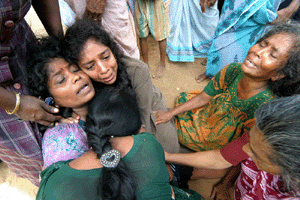 But the question that needs to be asked is, ‘At what point does the reality of the situation over-rule rhetoric?’ Norwegian peace monitors have admitted they think violence between the LTTE and the government is out of control. More recently a Japanese envoy arrived in Sri Lanka to try and save the faltering ceasefire agreement, which was signed in February 2002.
But the question that needs to be asked is, ‘At what point does the reality of the situation over-rule rhetoric?’ Norwegian peace monitors have admitted they think violence between the LTTE and the government is out of control. More recently a Japanese envoy arrived in Sri Lanka to try and save the faltering ceasefire agreement, which was signed in February 2002.
Ceasefire or not, Sri Lanka has just seen its bloodiest month since 2002 with almost 300 reported deaths, many of which were civilians. More than 64,000 people have died since the conflict began more than two decades ago when ethnic Tamil guerillas, who are fighting for their own homeland in the northeast, took up arms against the government.
Tensions are extremely high and there is an omnipresent feeling that recent events, as bloody as they have been, are just a preview of the human cost to come if the country returns to full-blown war. In Trincomalee for example, where the Tamil, Sinhalese and Muslim communities are so closely intertwined, a potential return to full-blown conflict poses a huge threat to the civilian population. Throughout Trincomalee, the recent rise in attacks between the government and LTTE has sparked numerous incidents of communal violence.
Local aid workers say that after a bombing in the Trincomalee market on April 12th, dubiously blamed on the LTTE, a heavily armed mob of Sinhalese descended on the site of the blast beating Tamils, burning homes and businesses, and raping women. As the riots spread throughout the city, 16 people were killed, 20 shops were destroyed and approximately 65 homes were torched. Locals and aid workers also confirm that while the Sri Lankan Navy had personnel stationed within full view of the attacks, they did nothing to subdue the mob.
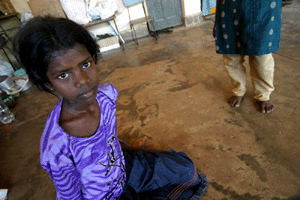
One shop owner, Ram Sundhar, entered the market area just after the blast. "I saw people running, excited," he says, "Then I saw a lot of bodies in the road. The saddest part is the navy soldiers were close by-in their uniforms-they saw everything and they did nothing."
Ram is the local distributor for Unilever. During the riots, his business, delivery trucks, several motorcycles and his car were torched.
"About five minutes after the blast 100 to 200 Sinhalese showed up. They were already equipped with weapons. How could that be in such a short time?"
"I got to my office, and we stayed inside there myself and about 15 of my staff. I was holding the backdoor open so my staff could escape when the mob broke through the front door. When they got inside they hit me and knocked me through a glass door." Though his business was destroyed, Ram managed to escape relatively unscathed.
Throughout April the violence continued to escalate. On April 25th a suspected LTTE suicide bomber killed 11 people in an assassination attempt of army chief Sarath Fonseka, which left him critically wounded. In response the government shelled the Muttur area in Trincomalee for two days in an attempt to knock out an LTTE training facility. In the process more than 15 people were killed, including four children. The shelling also damaged two schools, destroyed six homes and damaged almost 50 more.
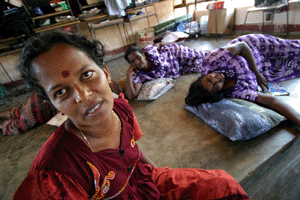
Though the exact number of persons displaced by the shelling is difficult to calculate, local aid agencies estimate that as a result of the attacks up to 10,000 people have been forced to flee their homes, many of which were living in tsunami resettlement camps at the time. This is in addition to the almost 11,000 who were already displaced in the area either as a result of war, communal violence or the tsunami.
When the first shells began to fall, Maheswaran Jeyasvi was at the Sooda Kuda Refugee camp. "We heard bombs falling. There were three blasts in front of the camp…a few houses were damaged. It started at about six [p.m.] and went on until midnight. That’s when we started walking."
Nakashaara Chelvanayaki and her daughter were also living in a tsunami resettlement camp when the shelling began in Chenaiyoor. "A bomb exploded right in front of our house," Nakashaara says, "My home is supposed to be temporary. It’s made of kajam leaf, so the bomb ripped large holes in the side."
Nakashaara and Maheswaran took shelter with their families in an overcrowded school in Pattalipuram with more than 1,000 other IDPs. After the shelling, camps like the one in Pattalipuram popped up all over in ‘clear’ and ‘unclear’ areas in Muttur District.
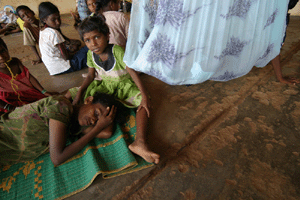
Two weeks after the initial shelling incident in Muttur most people began returning to their homes, but on May 11th the Sri Lankan military shelled Muttur again causing widespread displacement. The attack, which lasted 50 minutes, was in response to the sinking of a navy fast-attack craft off the coast of the Jaffna peninsula by a Tamil Tiger suicide boat.
With heightened tensions and the threat of danger, the reaction from most civilians in sensitive areas has been to cut their days in half, retreating into solitude in the afternoon. In Trincomalee, by 6 p.m. the main streets are almost completely vacant of human life. The only things audibly stirring are the crows and the local imam calling for evening prayers.
Throughout the day military personnel are stationed every 30 to 50 meters in town, a presence clearly focused on oppression, not protection. Civilians, young and old, are frequently stopped, searched and harassed at checkpoints. Shopping has to be done in the morning or early afternoon as most businesses have begun closing their shutters at two o’clock. Tamils have also refused to reopen their shops in the market, though most Sinhalese vendors have returned.
One Tamil aid worker admitted, "We too sometimes think about joining the LTT. If there is another war, we have only two choices: we can go abroad or we can join the LTT. But not everybody has the money to go abroad, do they?"
Overall, the violence shows no sign of abating, though much of it goes unreported. LTTE Claymore attacks persist on a daily basis and the SLA is dealing with allegations that the military is responsible for the deaths of thirteen civilians in the Jaffna area.
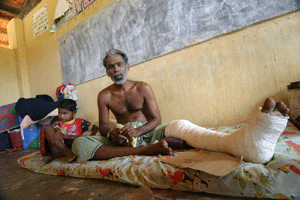
As the cycle continues day by day each side loses ground in the silent battle to win the hearts and minds of the people in areas directly affected by the conflict. With each attack and with each death, fragments of resentment are embedded in the minds of the common people. Every day there is a funeral to attend.
Thulasithasan, his mother Chitra, sister Vanitha, and the driver of the rickshaw, Praba, were buried two days after the blast that took their lives. Hundreds of friends and family attend the funerals.
At 10 o’clock firecrackers explode in the street and the caskets are carried out from the family homes, just around the corner from each other. Those who’ve come to pay their respects cry and clutch at each other in frantic remorse, pushing and swaying against one another in a powerful, fluid sobbing motion. Several women eventually collapse with the weight of their grief.
It’s a tragic image of human suffering, a reminder of the human cost of war. Like dozens of similar images it is helping to redefine the meaning of the word ‘ceasefire’ in Sri Lanka.
All photos by Will Baxter, a TowardFreedom.com writer currently based in Sri Lanka.
